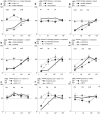The predatory mite Phytoseiulus persimilis does not perceive odor mixtures as strictly elemental objects
- PMID: 20872172
- PMCID: PMC2980619
- DOI: 10.1007/s10886-010-9858-3
The predatory mite Phytoseiulus persimilis does not perceive odor mixtures as strictly elemental objects
Abstract
Phytoseiulus persimilis is a predatory mite that in absence of vision relies on the detection of herbivore-induced plant odors to locate its prey, the two-spotted spider-mite Tetranychus urticae. This herbivorous prey is feeding on leaves of a wide variety of plant species in different families. The predatory mites respond to numerous structurally different compounds. However, typical spider-mite induced plant compounds do not attract more predatory mites than plant compounds not associated with prey. Because the mites are sensitive to many compounds, components of odor mixtures may affect each other's perception. Although the response to pure compounds has been well documented, little is known how interactions among compounds affect the response to odor mixtures. We assessed the relation between the mites' responses elicited by simple mixtures of two compounds and by the single components of these mixtures. The preference for the mixture was compared to predictions under three conceptual models, each based on one of the following assumptions: (1) the responses elicited by each of the individual components can be added to each other; (2) they can be averaged; or (3) one response overshadows the other. The observed response differed significantly from the response predicted under the additive response, average response, and overshadowing response model in 52, 36, and 32% of the experimental tests, respectively. Moreover, the behavioral responses elicited by individual compounds and their binary mixtures were determined as a function of the odor concentration. The relative contribution of each component to the behavioral response elicited by the mixture varied with the odor concentration, even though the ratio of both compounds in the mixture was kept constant. Our experiments revealed that compounds that elicited no response had an effect on the response elicited by binary mixtures that they were part of. The results are not consistent with the hypothesis that P. persimilis perceives odor mixtures as a collection of strictly elemental objects. They suggest that odor mixtures rather are perceived as one synthetic whole.
Figures


Similar articles
-
Complex odor from plants under attack: herbivore's enemies react to the whole, not its parts.PLoS One. 2011;6(7):e21742. doi: 10.1371/journal.pone.0021742. Epub 2011 Jul 13. PLoS One. 2011. PMID: 21765908 Free PMC article.
-
The perception of odor objects in everyday life: a review on the processing of odor mixtures.Front Psychol. 2014 Jun 2;5:504. doi: 10.3389/fpsyg.2014.00504. eCollection 2014. Front Psychol. 2014. PMID: 24917831 Free PMC article. Review.
-
Predatory mite attraction to herbivore-induced plant odors is not a consequence of attraction to individual herbivore-induced plant volatiles.J Chem Ecol. 2008 Jun;34(6):791-803. doi: 10.1007/s10886-008-9492-5. Epub 2008 Jun 3. J Chem Ecol. 2008. PMID: 18521678 Free PMC article.
-
Phytoseiulus persimilis response to herbivore-induced plant volatiles as a function of mite-days.Exp Appl Acarol. 2006;40(3-4):231-9. doi: 10.1007/s10493-006-9043-0. Epub 2007 Jan 16. Exp Appl Acarol. 2006. PMID: 17225078
-
The role of methyl salicylate in prey searching behavior of the predatory mite phytoseiulus persimilis.J Chem Ecol. 2004 Feb;30(2):255-71. doi: 10.1023/b:joec.0000017976.60630.8c. J Chem Ecol. 2004. PMID: 15112723
Cited by
-
Headspace volatiles from 52 oak species advertise induction, species identity, and evolution, but not defense.J Chem Ecol. 2013 Jan;39(1):90-100. doi: 10.1007/s10886-012-0224-5. Epub 2012 Dec 22. J Chem Ecol. 2013. PMID: 23264100
-
Parasitic Wasps Aphidius ervi are More Attracted to a Blend of Host-Induced Plant Volatiles than to the Independent Compounds.J Chem Ecol. 2015 Sep;41(9):801-7. doi: 10.1007/s10886-015-0615-5. Epub 2015 Aug 25. J Chem Ecol. 2015. PMID: 26302986
-
Silicon Supplementation Alters the Composition of Herbivore Induced Plant Volatiles and Enhances Attraction of Parasitoids to Infested Rice Plants.Front Plant Sci. 2017 Jul 19;8:1265. doi: 10.3389/fpls.2017.01265. eCollection 2017. Front Plant Sci. 2017. PMID: 28769965 Free PMC article.
-
Complex odor from plants under attack: herbivore's enemies react to the whole, not its parts.PLoS One. 2011;6(7):e21742. doi: 10.1371/journal.pone.0021742. Epub 2011 Jul 13. PLoS One. 2011. PMID: 21765908 Free PMC article.
-
The perception of odor objects in everyday life: a review on the processing of odor mixtures.Front Psychol. 2014 Jun 2;5:504. doi: 10.3389/fpsyg.2014.00504. eCollection 2014. Front Psychol. 2014. PMID: 24917831 Free PMC article. Review.
References
-
- BOLLAND HR, GUTIERREZ J, FLECHTMANN CHW. World Catalogue of the Spider Mite Family. The Netherlands, Brill: Leiden; 1998.
-
- DE BOER JG, DICKE M. Experience with methyl salicylate affects behavioural responses of a predatory mite to blends of herbivore-induced plant volatiles. Entomol. Exp. Appl. 2004;110:181–189. doi: 10.1111/j.0013-8703.2004.00133.x. - DOI
MeSH terms
LinkOut - more resources
Full Text Sources

